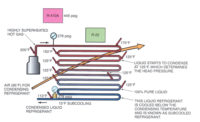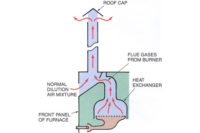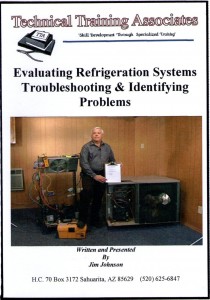Now, Bob’s company has promoted him to help train a new employee, right out of a school specializing in HVAC, just like Bob was. Bob is now Tim’s Btu Buddy. Tim is anxious to travel with Bob. Tim realizes that he is right out of school, with the theory and lab work that he accomplished in school, but still needs help. He knows that he worked with many of the components of the systems in the school, under ideal conditions with good light and air conditioning. Now it is into the field, sometimes under the house with poor lighting, or out on the rooftop in the sun, where the real action is. He is naturally and normally reluctant, but he has Bob to help guide him.
Bob and Tim have been tuning up a system with an orifice metering device for the correct evaporator charge, when Bob said, “There is another verse to tuning up a system, and it’s called subcooling.”
Tim asked, “How can we get more out of a system than we already have?”
Bob explained, “When a system is well matched, the correct evaporator coil and the correct condenser, it is best practice to get the most out of each coil. Many technicians don’t know that you can get a little extra efficiency out of the total system by charging the condenser to the correct charge. Up to now, we have charged the system for the evaporator. We have only worked with a fixed bore metering device. We have charged the system so that the evaporator will perform to capacity. More system capacity can be extracted out of the system with subcooling. How much? I have heard figures of 1 percent more capacity for each degree of subcooling. Most systems can be charged to 10° to 15°F of subcooling. If we are working with a 3-ton system (36,000 Btuh), 10° of subcooling could mean 3,600 to 5,400 more Btuh of cooling for the same amount of energy use. Not much, but in a closely matched to the load unit, it could be the difference in getting the house cool on one of those extra hot days.”
Tim said, “I would want my system to be efficient to the maximum.”
Bob went on to explain, “One time I was working on an office building with a 25-ton system and low charge. I charged the system until the sight glass was full just before the thermostatic expansion valve and stopped charging. The very next day, I had a call back to the job because the system was not cooling to the set point of the thermostat. The weather was really hot and when I looked at the system, the sight glass was still full. I was blaming it on the weather or an undersized system when my Btu Buddy showed up and told me to read the installation literature there on the job site about the equipment. I sat down and read it and it explained how subcooling pertained to that unit. I charged to 12° of subcooling and came back the next day and the building was under control with great conditions. That little bit of added refrigerant made the difference.”
Tim then said, “That made a big difference and was surely worth it. Why is subcooling so important, and how does it improve the system so much?”
Bob said, “Well to start with, subcooling is free energy added to the system and all it costs is a little more refrigerant. You probably remember from your classes that you have to have a clear liquid feeding the expansion device, with no bubbles. That assures you that the metering device has the correct quality of liquid. You also probably remember from your classes that the cooler the pure liquid is, the more capacity the evaporator has to remove heat from the structure.
“Remember what you want is:
1. Pure liquid to the expansion device.
2. Cooler pure liquid gives more evaporator capacity to the system.
“If you have to use extra energy to get that cooler liquid, you won’t get free cooling for the liquid.”
Tim asked, “Where does the free cooling come from?”
Bob said, “Let’s take a typical design day outside of 95°. We expect the condenser to condense the liquid refrigerant to about 30° warmer than the outdoor air for a standard condenser, or 25° higher for a high efficiency condenser or maybe even lower for a very high efficiency condenser.
“Let’s stick with a standard efficiency condenser and look at an example. We would have 95° air passing over the condenser while condensing at 125°. The liquid refrigerant at the pure liquid portion of the condenser would be 125°. All we have to do is use the 95° air to cool the liquid down a few degrees. The air is there, the fan is there, and there is room in the bottom of the condenser for some liquid to be cooled to below the condensing temperature. The ideal situation would be to cool the liquid refrigerant down to the ambient air temperature of 95°, but that is not economical because so much more condenser surface would need to be added. The manufacturers usually settle on 10° to 15° (Figure 1) or maybe even 20° in some cases.”
Tim asked, “Doesn’t it raise the head pressure when you start adding more refrigerant? Why do all technicians not charge to the correct subcooling?”
Bob said, “When you are adding refrigerant to accomplish subcooling levels, if the head pressure starts to rise and stay up, you have added all the refrigerant the system will allow. You cannot get more subcooling efficiency from the system. I think that too many of them do not understand how or realize that the customer would get the best efficiency. Let’s go to a job and see this in action.”
Bob and Tim were now at a job with a 5-ton unit and a thermostatic expansion device.
Bob said, “Our job is to make sure that this system is operating efficiently. The first thing that we should do is make sure that the evaporator is operating efficiently by checking the superheat. It is a thermostatic expansion valve system, so the superheat should be between 8° and 12° at the evaporator outlet (Figure 2).
“It is only 85° today, so we will have to cover part of the condenser and raise the head pressure to about 278 psig corresponding to a 95° day since this system uses R-22. Then we will check the subcooling temperature at the liquid line leaving the condensing unit. There is a pressure tap there where we can take the temperature; we will take the liquid line temperature there also.”
With their gauges installed and temperature leads attached, Tim asked, “What will the superheat be at the condensing unit? The line set is about 40 feet from the evaporator to the condensing unit where we are taking the suction pressure reading.”
Bob said, “Superheat will be picked up in the long suction line. We will have to make an assumption here. Suppose the superheat we are expecting is 10° when it leaves the evaporator and it picks up enough superheat to rise to 15° to 18° superheat when it reaches the condensing unit. That should be estimated to be a good superheat for this installation.”
Tim partially blocked the condenser until the head pressure was 278 psig and they were letting the system run and settle down and he said, “The superheat is 17° just as you predicted, but the liquid line temperature is 120°. That is a subcooling of only 5° (278 psig is a condensing temperature of 125° - 120° = 5° subcooling). Tell me again what I am seeing.”
Bob said, “The condenser is charged with enough liquid to feed the TXV but we can make it even more efficient by adding enough refrigerant to reach a subcooling temperature of 10° to 15°. This will give us greater efficiency and will not raise the head pressure.
“Another thing to remember is on a hot pull down, when the house temperature is higher than normal, the TXV will be more efficient. The reason for this is the TXV is a variable flow device. On a hot pull down, the valve will open further because the evaporator will be boiling more refrigerant. When this happens, if the condenser has a charge with low subcooling, the condenser may run low of pure liquid feeding the TXV and bubbles of vapor refrigerant will pass through the TXV.”
Tim gradually charged vapor into the system until the unit had 15° of subcooling (Figure 3), and Bob said, “Tim, you have this system doing all it can do; it is running at maximum efficiency. We are done.”
Tim then said, “We have used subcooling to charge this unit. How does subcooling figure into a capillary tube system. It seems to me that those systems should have subcooling in the condenser also.”
Bob said, “Tim, that is a great question and I am glad that you thought of it. You are thinking and that is great.
“Yes, fixed bore metering devices such as capillary tube systems should be charged to the correct superheat, then add enough refrigerant to the system to bring the subcooling up to between 10° and 15°, and you will get the most out of the system. It will be the most efficient.”
Bob then said, “Now, let’s summarize what we did:
1. We made sure the system was operating as close to the design conditions for the equipment. This will assure us that the expansion device has the correct pressure drop across it for the correct flow rate.
2. Then we checked the evaporator superheat to make sure that the evaporator was operating efficiently.
3. Then we added enough refrigerant to the system to reach about 15° of subcooling.
“You should also realize that many manufacturers place charging charts in the panels of their systems. When you have a charging chart, you should use that. This procedure should closely resemble that chart.”
Tim said as they were riding off, “This just gets more interesting as we go along. Some people don’t enter this career because they think it doesn’t take any thinking. Boy, are they wrong, and I am making a great salary.”
Bob then said, “I have made a career out of this field because it has done so well for me, because I continue to learn new systems and techniques. It is endless.”
To see the preceding articles on superheat, go to Btu Buddy 124: Superheat Explained - Part 1 and Btu Buddy 125: Superheat Explained - Part 2.
Publication date: 9/23/2013
Want more HVAC industry news and information? Join The NEWS on Facebook, Twitter, and LinkedIn today!













